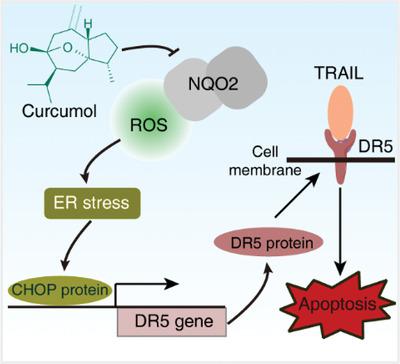Our official English website, www.x-mol.net, welcomes your feedback! (Note: you will need to create a separate account there.)
Curcumol Overcomes TRAIL Resistance of Non‐Small Cell Lung Cancer by Targeting NRH:Quinone Oxidoreductase 2 (NQO2)
Advanced Science ( IF 15.1 ) Pub Date : 2020-10-15 , DOI: 10.1002/advs.202002306 Jing Zhang 1, 2 , Ye Zhou 1 , Nan Li 1 , Wan-Ting Liu 1 , Jun-Ze Liang 1 , Yue Sun 1 , Wei-Xia Zhang 1 , Run-Dong Fang 1 , Sheng-Ling Huang 2 , Zheng-Hua Sun 1 , Yang Wang 1 , Qing-Yu He 1, 2
Advanced Science ( IF 15.1 ) Pub Date : 2020-10-15 , DOI: 10.1002/advs.202002306 Jing Zhang 1, 2 , Ye Zhou 1 , Nan Li 1 , Wan-Ting Liu 1 , Jun-Ze Liang 1 , Yue Sun 1 , Wei-Xia Zhang 1 , Run-Dong Fang 1 , Sheng-Ling Huang 2 , Zheng-Hua Sun 1 , Yang Wang 1 , Qing-Yu He 1, 2
Affiliation

|
Resistance to tumor‐necrosis‐factor‐related apoptosis‐inducing ligand (TRAIL) of cancer cell remains a key obstacle for clinical cancer therapies. To overcome TRAIL resistance, this study identifies curcumol as a novel safe sensitizer from a food‐source compound library, which exhibits synergistic lethal effects in combination with TRAIL on non‐small cell lung cancer (NSCLC). SILAC‐based cellular thermal shift profiling identifies NRH:quinone oxidoreductase 2 (NQO2) as the key target of curcumol. Mechanistically, curcumol directly targets NQO2 to cause reactive oxygen species (ROS) generation, which triggers endoplasmic reticulum (ER) stress‐C/EBP homologous protein (CHOP) death receptor (DR5) signaling, sensitizing NSCLC cell to TRAIL‐induced apoptosis. Molecular docking analysis and surface plasmon resonance assay demonstrate that Phe178 in NQO2 is a critical site for curcumol binding. Mutation of Phe178 completely abolishes the function of NQO2 and augments the TRAIL sensitization. This study characterizes the functional role of NQO2 in TRAIL resistance and the sensitizing function of curcumol by directly targeting NQO2, highlighting the potential of using curcumol as an NQO2 inhibitor for clinical treatment of TRAIL‐resistant cancers.
中文翻译:

姜黄素通过靶向 NRH:醌氧化还原酶 2 (NQO2) 克服非小细胞肺癌的 TRAIL 耐药性
癌细胞对肿瘤坏死因子相关凋亡诱导配体(TRAIL)的耐药性仍然是临床癌症治疗的主要障碍。为了克服 TRAIL 耐药性,本研究从食物源化合物库中鉴定出姜黄酚作为一种新型安全敏化剂,与 TRAIL 联合使用对非小细胞肺癌 (NSCLC) 表现出协同致死作用。基于 SILAC 的细胞热位移分析将 NRH:醌氧化还原酶 2 (NQO2) 确定为姜黄醇的关键靶标。从机制上讲,姜黄酚直接靶向 NQO2 引起活性氧 (ROS) 生成,从而触发内质网 (ER) 应激-C/EBP 同源蛋白 (CHOP) 死亡受体 (DR5) 信号传导,使 NSCLC 细胞对 TRAIL 诱导的细胞凋亡敏感。分子对接分析和表面等离振子共振分析表明,NQO2 中的 Phe178 是姜黄酚结合的关键位点。Phe178 的突变完全废除了 NQO2 的功能并增强了 TRAIL 敏化作用。本研究通过直接靶向 NQO2 表征了 NQO2 在 TRAIL 耐药中的功能作用以及姜黄醇的增敏功能,突出了姜黄醇作为 NQO2 抑制剂用于临床治疗 TRAIL 耐药癌症的潜力。
更新日期:2020-11-19
中文翻译:

姜黄素通过靶向 NRH:醌氧化还原酶 2 (NQO2) 克服非小细胞肺癌的 TRAIL 耐药性
癌细胞对肿瘤坏死因子相关凋亡诱导配体(TRAIL)的耐药性仍然是临床癌症治疗的主要障碍。为了克服 TRAIL 耐药性,本研究从食物源化合物库中鉴定出姜黄酚作为一种新型安全敏化剂,与 TRAIL 联合使用对非小细胞肺癌 (NSCLC) 表现出协同致死作用。基于 SILAC 的细胞热位移分析将 NRH:醌氧化还原酶 2 (NQO2) 确定为姜黄醇的关键靶标。从机制上讲,姜黄酚直接靶向 NQO2 引起活性氧 (ROS) 生成,从而触发内质网 (ER) 应激-C/EBP 同源蛋白 (CHOP) 死亡受体 (DR5) 信号传导,使 NSCLC 细胞对 TRAIL 诱导的细胞凋亡敏感。分子对接分析和表面等离振子共振分析表明,NQO2 中的 Phe178 是姜黄酚结合的关键位点。Phe178 的突变完全废除了 NQO2 的功能并增强了 TRAIL 敏化作用。本研究通过直接靶向 NQO2 表征了 NQO2 在 TRAIL 耐药中的功能作用以及姜黄醇的增敏功能,突出了姜黄醇作为 NQO2 抑制剂用于临床治疗 TRAIL 耐药癌症的潜力。



























 京公网安备 11010802027423号
京公网安备 11010802027423号